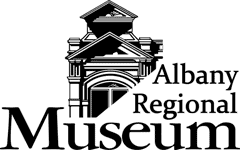By Cathy Ingalls, Albany Regional Museum board member
Starting in Albany during the late 1860s, a group of men banded together, choosing to set themselves apart from others in the community by wearing special badges, donning ceremonial belts and carrying ornate, metal speaking horns.
They had to be voted into the association and then pay a $2 joining fee. Sounds like a fraternal organization doesn’t it. Well partly.
Members were the resident volunteers that served in the city’s early firefighting companies, according to Darrel Tedisch, Albany’s fire chief from January 1988 to June 1999. Of those, many were prominent people in the community, and in addition to putting out fires they held meetings and arranged for and took part in citywide events.
Volunteers were used exclusively in Albany until 1919, when firefighters were paid, however the department still relied on volunteers.
Prior to the formation of the fire department, bucket brigades were the means used to put out fires.
Tedisch, along with several others, served as advisers in developing a new display at the Albany Regional Museum that commemorates the 150th anniversary of the founding of the city’s fire service.
Collections and exhibits manager, Amy Bozorth, arranged the artifacts loaned to the museum for the project by placing them behind glass cases, and she created storyboards containing photographs and information about the department, which will be on display for at least “a couple years,” she said.
In the beginning, members of Albany Engine Company No. 1 assembled in 1869, and physically pulled equipment to fires as horses were yet to be employed to do the work, Tedisch said.
The fire hoses were about 100 feet long each, and there were usually five hoses on each cart. The hoses were made primarily of two layers of a heavy cotton material.
At first, fire officials opted against using horses because there were not enough fires in town to pay to stable the animals.
Later when the animals were needed, delivery drivers upon hearing the fire notification bell ring on top of the courthouse drove their horses to the fire station at first located between Second and Lyon streets and then south of the former post office, which later became city hall. There, the horses were unharnessed and hooked up to firefighting equipment.
Water to fight fires came from the Santiam-Albany Canal that had been diverted into eight to 11 cisterns located under the city’s streets. The cisterns were made of brick and could hold about 10,000 gallons of water, Tedisch said. He believes that all of the cisterns have been filled in.
Water from wells and ponds also was tapped to douse those early fires.
In 1880, the city purchased a hook and ladder truck to fight fires that broke out in Albany’s newly built taller buildings. Firefighters used the hooks to pull burned and burning material from those structures.
At the museum, there are a number of vintage fire-related artifacts on display.
They include hoses, badges, nozzles, helmets, transmitters, a fire alarm box, extinguishers, breathing apparatus and uniforms called turnouts, which refers to the time-saving practice of always keeping pant legs turned over the top of boots to allow easy access.
There also is a continually running video made by a representative of the Ford Motor Co. that came to Albany in 1920 to film the city’s steam-powered fire apparatus in action. Ford tractors pulled that equipment.
Also in the exhibit area, children can try on miniature firefighter clothing, boots and helmets.
Interestingly enough, there are no photos of Dalmatians with Albany firefighters because there were not enough fires to keep dogs on the staff, Tedisch said.
On the East Coast, where there were more fires, the dogs were employed to run alongside the fire equipment that was pulled by horses. The Dalmatians, which like to run, chased away the dogs that came out to attack and/or harass the horses.
For more information about the exhibit, contact the museum at 541-967-7122.
The museum at 136 Lyon St. N.W. is open between 11 a.m. and 4 p.m. Tuesday through Friday and 10 a.m. to 2 p.m. Saturday.

